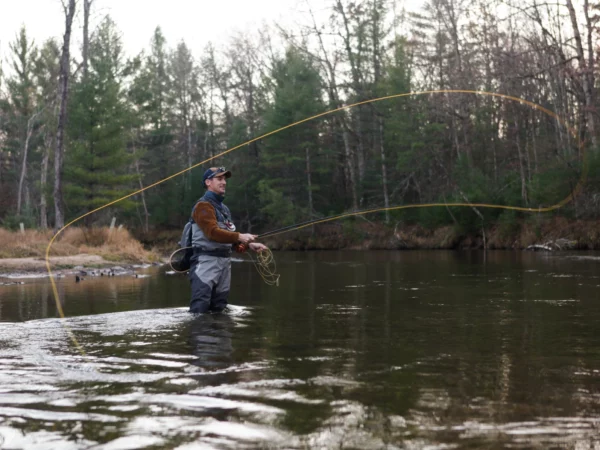
Sea lamprey control in the Great Lakes has been a success.
Compared to the 1950s, 90% fewer of the toothy, invasive, eel-like parasite are spawning.
Control efforts have been so successful that some researchers now suggest a more permanent solution: complete eradication of the pest from the Great Lakes.
It’s a possibility that requires more research and technological advances, but the suggestion is a shift from long-standing beliefs about lamprey eradication: that it’s a fantasy not worth considering.
“To be candid, there’s never been anything published up until the present day that has really asked that question in any sort of scientific sense,” said Michael Jones, emeritus professor of fisheries and wildlife at Michigan State University, whose research first raised the possibility.

Dead lamprey larvae are the result of a successful lampricide treatment. (Credit: R. McDaniels, Great Lakes Fisheries Commission)
Migration remains a barrier to eradication
The central question to eradicating any invasive species is “can you remove more individuals than the population is capable of replenishing?” said Jones.
The Great Lakes Fishery Commission reported that, in 2019, sea lamprey levels for the five Great Lakes were well below their historic levels. Lakes Michigan and Ontario had 93% fewer sea lamprey than they did historically. The other three lakes were below historic levels by 84% (Huron), 76% (Superior) and 50% (Erie).
Research suggests a removal rate of 90% leads to eradication, so the reductions in sea lamprey in lakes Michigan and Ontario should be enough to achieve eradication. That prompts an obvious question.
“Why are they still here?” Jones said.
According to Jones, sea lamprey remain in lakes Michigan and Ontario because others simply migrate in from the other lakes. Eradication efforts would need to be basin wide, but the most widespread method of removing lamprey, poisons called lampricides, don’t work in every stream lamprey occupy.
Genetic tools a possibility
While you can’t remove lamprey you can’t reach, new control methods in a category called genetic biocontrol could help researchers target lamprey inaccessible to lampricide.
Genetic biocontrol involves changing lamprey’s DNA and releasing them into the wild, where they can access streams where lampricides don’t work. Their offspring might not be able to survive or might pass on some trait that ultimately works against the species’ survival in the Great Lakes.
In one possible method, researchers might genetically manipulate sea lamprey to produce only males and non-viable females. After several generations, a population might collapse when no females remain to produce viable offspring.
In a distinct technique, called sterile male release, manipulated DNA isn’t passed to a new generation. Instead, sterilized males are released. If they outnumber fertile males, every female might end up mating with a lamprey that can’t reproduce.

Sterilized male sea lamprey are released back into the wild. (Credit: Marc Gaden, Great Lakes Fisheries Commission)
From 2017 to 2019, experimental sterile male release reduced or eliminated sea lamprey from rivers with small lamprey populations, said Nicholas Johnson, research ecologist at the US Geological Survey’s Hammond Bay Biological Station.
A new research station built at Hammond Bay is equipped to house future genetic biocontrol experiments, Johnson said, though no experiments are currently underway or planned.
New lamprey control tools are important as old ones fall out of favor or become ineffective.
“We do have a time of grace now to develop supplemental controls and alternative controls to hopefully provide the control program we might need 10, 20, 30 years down the road,” Johnson said.
Barriers to sea lamprey eradication
Dams have been vital in controlling sea lamprey populations.
They block lamprey from spawning habitat upstream, which means fewer lamprey born. However, they also block desirable fish like salmon and native trout.
Barriers that block lamprey without blocking desirable fish could further restrict lamprey spawning habitat.
FishPass in Traverse City, Michigan, a project of the Great Lakes Fishery Commission and its partners, aims to develop a sort of “single stream recycling” system for sorting fish, blocking some while allowing others past, said Dan Zielinski, principal researcher at FishPass.
FishPass is designed to develop and test sorting techniques and create systems suited to the fish populations at specific streams and rivers. A hypothetical system might sort fish by size and use image recognition technology. It might also deter undesirable fish with light and sounds or pheromones and alarm cues, while trapping lamprey for removal from the river.
As new barriers or replacements for old ones, FishPass technology could further limit spawning habitat for lamprey, even as dam removal gains in popularity in some circles.
Is eradication possible?
Jones says his research is meant to spark a conversation.
“It’s mostly just a provocation,” Jones said. “Sea lamprey eradication is worth considering, is worth entertaining, is worth giving more serious thought.”
And it has helped provoke conversation.
“This is the kind of fresh thinking that is very interesting to us,” said Marc Gaden, communications director for the Great Lakes Fisheries Commission. “It is most certainly being talked about by the commissioners.”
Many questions need to be answered before anyone considers eradication a sure bet. Gaden notes, as the study does, the need for a cost-benefit analysis, the actual arrival and approval of these new technologies, and continued public support.
But if eradication does occur, it starts with conversations like the one occurring now.
Read more on invasive species on Great Lakes Now:
Invasive aquatic plant found in 4 Michigan inland lakes
Quiz: What Great Lakes invasive species are you?
Least Wanted: Potential Great Lakes invasive species are little known but still a big problem
API key not valid. Please pass a valid API key.Featured image: Advances in technology could bring sea lamprey eradication within reach. (Credit: Great Lakes Fisheries Commission)
2 Comments
-
An entity charged with minimizing or eradicating sea lamprey in the Great Lakes should not introduce “daughterless” genes without consent of all countries who share the species in its native Atlantic Ocean.
-
i dont think you understood the mechanism in the article




